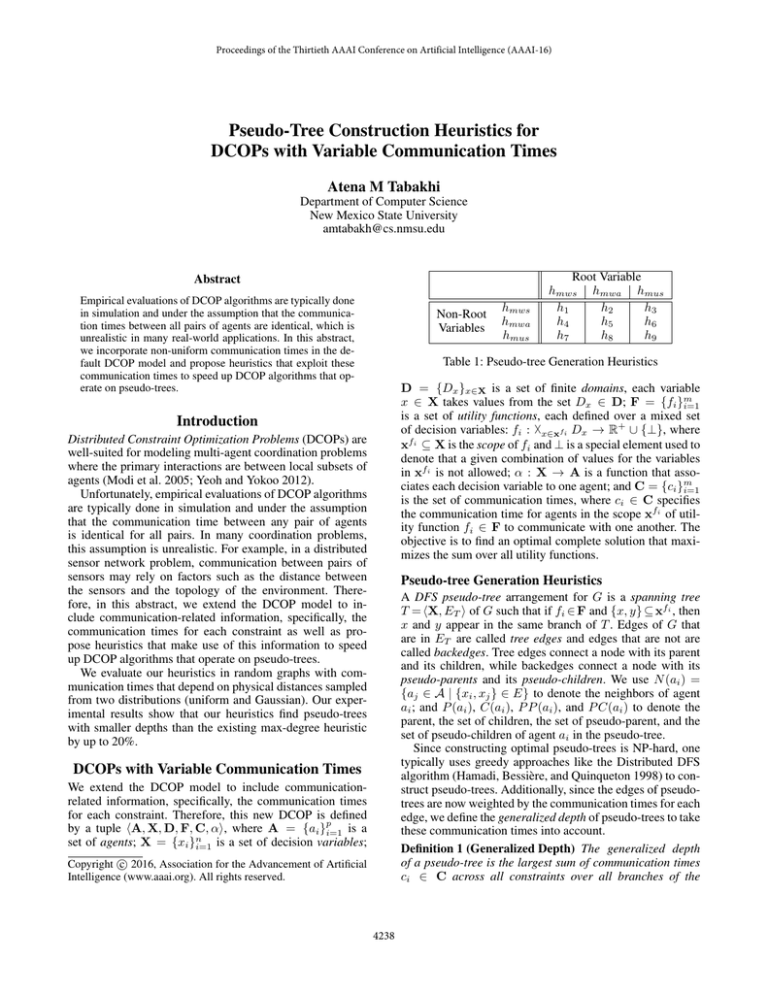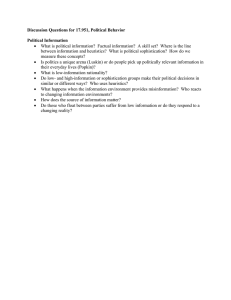
Proceedings of the Thirtieth AAAI Conference on Artificial Intelligence (AAAI-16)
Pseudo-Tree Construction Heuristics for
DCOPs with Variable Communication Times
Atena M Tabakhi
Department of Computer Science
New Mexico State University
amtabakh@cs.nmsu.edu
Abstract
Empirical evaluations of DCOP algorithms are typically done
in simulation and under the assumption that the communication times between all pairs of agents are identical, which is
unrealistic in many real-world applications. In this abstract,
we incorporate non-uniform communication times in the default DCOP model and propose heuristics that exploit these
communication times to speed up DCOP algorithms that operate on pseudo-trees.
Non-Root
Variables
hmws
hmwa
hmus
Root Variable
hmws hmwa hmus
h1
h2
h3
h4
h5
h6
h7
h8
h9
Table 1: Pseudo-tree Generation Heuristics
D = {Dx }x∈X is a set of finite domains, each variable
x ∈ X takes values from the set Dx ∈ D; F = {fi }m
i=1
is a set of utility functions, each defined over a mixed set
of decision variables: fi : x∈xfi Dx → R+ ∪ {⊥}, where
xfi ⊆ X is the scope of fi and ⊥ is a special element used to
denote that a given combination of values for the variables
in xfi is not allowed; α : X → A is a function that associates each decision variable to one agent; and C = {ci }m
i=1
is the set of communication times, where ci ∈ C specifies
the communication time for agents in the scope xfi of utility function fi ∈ F to communicate with one another. The
objective is to find an optimal complete solution that maximizes the sum over all utility functions.
Introduction
Distributed Constraint Optimization Problems (DCOPs) are
well-suited for modeling multi-agent coordination problems
where the primary interactions are between local subsets of
agents (Modi et al. 2005; Yeoh and Yokoo 2012).
Unfortunately, empirical evaluations of DCOP algorithms
are typically done in simulation and under the assumption
that the communication time between any pair of agents
is identical for all pairs. In many coordination problems,
this assumption is unrealistic. For example, in a distributed
sensor network problem, communication between pairs of
sensors may rely on factors such as the distance between
the sensors and the topology of the environment. Therefore, in this abstract, we extend the DCOP model to include communication-related information, specifically, the
communication times for each constraint as well as propose heuristics that make use of this information to speed
up DCOP algorithms that operate on pseudo-trees.
We evaluate our heuristics in random graphs with communication times that depend on physical distances sampled
from two distributions (uniform and Gaussian). Our experimental results show that our heuristics find pseudo-trees
with smaller depths than the existing max-degree heuristic
by up to 20%.
Pseudo-tree Generation Heuristics
A DFS pseudo-tree arrangement for G is a spanning tree
T = X, ET of G such that if fi ∈ F and {x, y} ⊆ xfi , then
x and y appear in the same branch of T . Edges of G that
are in ET are called tree edges and edges that are not are
called backedges. Tree edges connect a node with its parent
and its children, while backedges connect a node with its
pseudo-parents and its pseudo-children. We use N (ai ) =
{aj ∈ A | {xi , xj } ∈ E} to denote the neighbors of agent
ai ; and P (ai ), C(ai ), P P (ai ), and P C(ai ) to denote the
parent, the set of children, the set of pseudo-parent, and the
set of pseudo-children of agent ai in the pseudo-tree.
Since constructing optimal pseudo-trees is NP-hard, one
typically uses greedy approaches like the Distributed DFS
algorithm (Hamadi, Bessière, and Quinqueton 1998) to construct pseudo-trees. Additionally, since the edges of pseudotrees are now weighted by the communication times for each
edge, we define the generalized depth of pseudo-trees to take
these communication times into account.
Definition 1 (Generalized Depth) The generalized depth
of a pseudo-tree is the largest sum of communication times
ci ∈ C across all constraints over all branches of the
DCOPs with Variable Communication Times
We extend the DCOP model to include communicationrelated information, specifically, the communication times
for each constraint. Therefore, this new DCOP is defined
by a tuple A, X, D, F, C, α, where A = {ai }pi=1 is a
set of agents; X = {xi }ni=1 is a set of decision variables;
c 2016, Association for the Advancement of Artificial
Copyright Intelligence (www.aaai.org). All rights reserved.
4238
max ck + dˆxj
fk ∈F:{xi ,xj }∈xfk ∧xj ∈C(xi )∪P C(xi )
(1)
where fk is the constraint between xi and its child or
pseudo-child xj , ck is the communication time associated
with that function, and dˆxj is the generalized depth of the
sub-tree rooted at xj .
9
G
h1
h2
h7
h9
6
G
3
0
−3
−6
−9
−12
G
G
−15
G
20
30
40
50
Number of Variables
60
G
G
G
10
20
30
40
50
Number of Variables
h1
h2
h7
h9
60
(b) Gaussian Distribution
Figure 1: Random Graphs
0.3. For each configuration, we sample the physical distances di of the constraints from two possible truncated distributions – uniform and Gaussian N (50, 25) – from the
range [1,100] and define the communication time ci = C ·di
with these distances, where we set C = 1 millisecond per
meter. We measure the generalized depths of pseudo-trees
constructed by the heuristics and use them as proxies for
runtimes of DCOP algorithms that operate on pseudo-trees.
Figure 1 shows the results, where we plot the four best
heuristics. Generally, the savings increase as the number of
variables increases. The reason is because the number of
possible pseudo-tree configurations increases as the number
of variables increases. Thus, there is more room for improvement. The h1 and h2 heuristics converge to larger savings
(≈18% with the uniform distribution and ≈15% with the
Gaussian distribution) than the other two h7 and h9 heuristics (≈6% in both distributions), indicating that heuristics
that take the communication times into account perform better than those that do not.
It sums the communication times between variable xi and
all its neighbors xj that are not yet part of the pseudotree. We thus ignore neighbors that are already part of the
pseudo-tree in this heuristic and both heuristics below.
• The max-weighted-average (mwa) heuristic hmwa :
Conclusions
In this abstract, we incorporate non-uniform communication
times in the default DCOP model in order to better reflect
real-world applications and propose pseudo-tree construction heuristics that exploit these communication times to
find pseudo-trees that are up to 20% shorter than pseudotrees constructed by the max-degree heuristic. These heuristics can thus be used to speed up a large class of DCOP
algorithms that operate on pseudo-trees.
(3)
It is identical to the previous hmws heuristic except that it
averages the values over the number of neighboring variables that are not yet part of the pseudo-tree.
• The max-unweighted-sum (mus) heuristic hmus :
hmus (xi ) = |N (xi ) \ [{P (xi )} ∪ P P (xi )] |
G
12
G
(a) Uniform Distribution
fk ∈F:{xi ,xj }∈xfk ∧xj ∈N (xi )\[{P (xi )}∪P P (xi )]
hmws (xi )
|N (xi ) \ [{P (xi )} ∪ P P (xi )] |
15
G
G
G
10
It is straightforward to see that this generalized depth definition subsumes the previous depth definition for pseudo-trees
with uniform communication times of 1.
Complete DCOP algorithms typically require that the
variables in the problem be ordered according to some complete ordering in which case the variables are ordered into
a pseudo-tree; a large number of complete algorithms, including ADOPT (Modi et al. 2005) and DPOP (Petcu and
Faltings 2005), operate on pseudo-trees. The Distributed
DFS algorithm assigns a score to each variable according
to some heuristic and initiates a DFS-traversal of the constraint graph, greedily adding the neighboring variable with
the largest score as the child of the current variable. The variables’ scores can be chosen arbitrarily. A commonly used
heuristic is the max-degree heuristic h(xi ) = |N (xi )|. We
thus introduce heuristics that can be used by Distributed
DFS to create pseudo-trees with small generalized depths:
• The max-weighted-sum (mws) heuristic hmws :
ck
(2)
hmws (xi ) =
hmwa (xi ) =
G
Savings in Depth (%)
dˆxi =
21
18
15
12
9
6
3
0
−3
−6
−9
−12
−15
Saving in Depth (%)
pseudo-tree. More specifically, the generalized depth dˆ∗ =
dˆroot and is defined recursively by:
References
(4)
Hamadi, Y.; Bessière, C.; and Quinqueton, J. 1998. Distributed intelligent backtracking. In Proceedings of ECAI,
219–223.
Modi, P.; Shen, W.-M.; Tambe, M.; and Yokoo, M. 2005.
ADOPT: Asynchronous distributed constraint optimization
with quality guarantees. Artificial Intelligence 161(1–
2):149–180.
Petcu, A., and Faltings, B. 2005. A scalable method for
multiagent constraint optimization. In Proceedings of IJCAI,
1413–1420.
Yeoh, W., and Yokoo, M. 2012. Distributed problem solving. AI Magazine 33(3):53–65.
It is identical to the default max-degree heuristic except
that it considers only neighboring variables that are not
yet part of the pseudo-tree.
Table 1 tabulates nine combination of heuristics because the
heuristic used to select the root of the pseudo-tree can differ
from the heuristic used to select non-root variables.
Experimental Results
We empirically evaluate our 9 heuristics, tabulated in Table 1, against the default max-degree heuristic on random graphs. We vary the number of variables |X| =
{10, 20, 30, 40, 50, 60} and set the constraint density p1 =
4239









